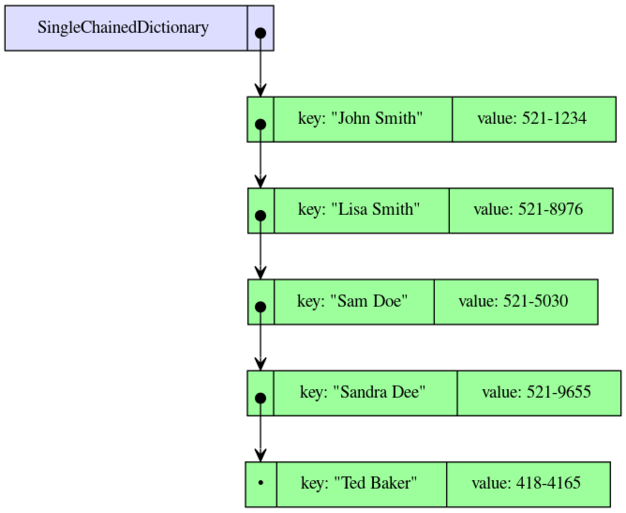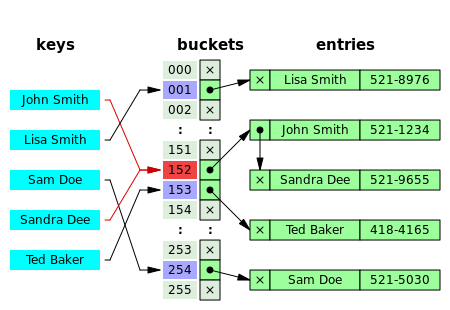Chained Dictionary Assignment
Contents
Motivation
In this and the follow up Sorted Dictionary studio, you will build three implementations of a dictionary. Each will be a persistent, mutable data structure, so you can expect to use the ref feature of SML, either directly or via the mutable Array structure.
Background
SML
ref
fun get_value_at_reference(reference : 'a ref) : 'a =
!reference
fun set_value_at_reference(reference : 'a ref, next_value : 'a) : 'a =
let
val previous_value = !reference
val _ = reference := next_value
in
previous_value
end
(* alternate version
fun set_value_at_reference(reference : 'a ref, next_value : 'a) : 'a =
let
val previous_value = !reference
in
( reference := next_value
; previous_value )
end
*)
Mutable Array
HashTable
Code To Investigate
signature Dictionary
signature DICTIONARY = sig
type (''k,'v) dictionary
val get : ((''k,'v) dictionary *''k) -> 'v option
val put : ((''k,'v) dictionary *''k *'v) -> 'v option
val remove : ((''k,'v) dictionary *''k) -> 'v option
val entries : (''k,'v) dictionary -> (''k*'v) list
val keys : (''k,'v) dictionary -> ''k list
val values : (''k,'v) dictionary -> 'v list
end
get
Behaves much like java.util.Map<K,V>'s get(key) method except instead of returning null or the associated value, it returns an option.
put
Behaves much like java.util.Map<K,V>'s put(key,value) method except instead of returning null or the previously associated value, it returns an option.
remove
Behaves much like java.util.Map<K,V>'s remove(key) method except instead of returning null or the previously associated value, it returns an option.
entries
Behaves much like java.util.Map<K,V>'s entrySet() method.
keys
Behaves much like java.util.Map<K,V>'s keySet() method.
values
Behaves much like java.util.Map<K,V>'s values() method.
Code To Implement
functor HasEntriesFn
Each implementation of dictionary can reuse the same functions which given a list of entries produce the keys and values. functor HasEntriesFn accepts a signature parameter which defines an entries function to support keys and values functions.
functor HasEntriesFn (HasEntriesParameter : sig
type (''k,'v) dictionary
val entries : (''k,'v) dictionary -> (''k*'v) list
end) : HAS_ENTRIES = struct
keys
One of List's higher order functions can be useful here. Which one is it?
fun keys(dict : (''k,'v) dictionary) : ''k list =
raise Fail "NotYetImplemented"
values
One of List's higher order functions can be useful here. Which one is it?
fun values(dict : (''k,'v) dictionary) : 'v list =
raise Fail "NotYetImplemented"
functor HasChainingFn
One can anticipate that separate structures for SingleChainedDictionary and HashedDictionary have potential for code resuse. By parameterizing functor HasChainingFn with getChainOfEntriesForKey and setChainOfEntriesForKey we can implement get, put, and remove.
functor HasChainingFn (HasChainingParameter : sig
type (''k,'v) dictionary
val getChainOfEntriesForKey : ((''k,'v) dictionary * ''k) -> (''k*'v) list
val setChainOfEntriesForKey : ((''k,'v) dictionary * ''k * (''k*'v) list) -> unit
end) : HAS_CHAINING = struct
get
put
remove
SingleChained Implementation
signature SINGLE_CHAINED_DICTIONARY = sig include DICTIONARY
val create : unit -> (''k,'v) dictionary
end
Hashtable Implementation
signature HASHED_DICTIONARY = sig include DICTIONARY
type ''k hash_function = ''k -> int
val create_hashed : (int * ''k hash_function) -> (''k,'v) dictionary
end
Testing
file: sml run_chained_testing.sml
in folder: src/test/sml/dictionary/chained
Pledge, Acknowledgments, Citations
file:
studio-dictionary-pledge-acknowledgments-citations.txt
More info about the Honor Pledge

